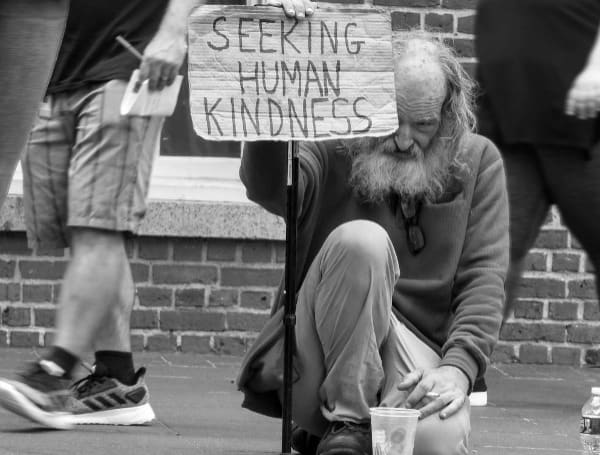Homelessness has continued to surge in California despite the state pouring billions into the crisis since 2019, with experts pointing to a lack of housing availability and the state’s relaxed views on crime as the reasons.
The crisis has worsened year after year, with homelessness most recently increasing 6.2% between 2021 and 2022 and 23.4% between 2007 and 2022, bringing the total number to over 170,000, according to the U.S. Department of Housing and Urban Development (HUD).
Democratic California Gov. Gavin Newsom has responded to the crisis by committing more than $30 billion to addressing housing and homelessness since taking office in 2019, even as the numbers continue to climb, according to a press release.
“There are billions of dollars that are squandered,” Joel Griffith, a research fellow in the Thomas A. Roe Institute for Economic Policy Studies at The Heritage Foundation, told the Daily Caller News Foundation. “I would say much of the money that supposedly was targeting those who are homeless has been misspent as well because they are not getting to the root of the problem, so the funds are there. It’s just a matter of using those resources.”
From the start of fiscal year 2018 to the end of fiscal year 2021, the state spent $9.6 billion on homelessness programs that were used by 571,246 unique people, according to a report from the California Interagency Council on Homelessness. Newsom signed a $22 billion bill in September 2021, with $12 billion of that going toward homelessness and the other $10 billion going toward housing affordability, according to a press release from the governor.
In the news: New York Rep. Elise Stefanik To Help Throw In $100 Million To Defend Swing Districts In 2024
Despite the spending, California has added more than 32,000 more homeless people since 2007 and makes up 30% of the total homeless population in the U.S., according to HUD.
“Places that have very expensive housing and have limited housing supply, like California, when they instituted policies like Housing First, it didn’t work out so well for them,” Vanessa Calder, director of opportunity and policy studies at the Cato Institute, told the DCNF. “At least in the case of California and Utah, homelessness has really increased after instituting housing first policies.”
California’s main policy to alleviate homelessness since 2016 is categorized under “Housing First,” which prioritizes giving homeless people permanent housing before addressing other factors like increasing income, improving health or otherwise stabilizing the person’s situation, according to the California Department of Housing and Community Development.
But California is undergoing a housing crisis as costs remain high and demand outpaces supply, with the state ranking last out of all 50 states for housing affordability, according to The U.S. News & World Report.
“There are so many barriers to housing development in California and in other states, too,” Calder told the DCNF. “Homelessness increases as land use freedom declines, and it increases as housing affordability declines.”
Los Angeles recently joined the list of cities, including San Francisco, San Jose, Santa Cruz and Napa, where the median listing price for a home is over $1 million, according to The Guardian. Over the past five years, the median home price has risen by more than 30% in Los Angeles.
In the news: Trump Urges House Republicans To Get Moving On Impeaching Biden, Or “Fade Into Oblivion”
“They’ve actually incentivized more homelessness through a number of the policies that are in effect,” Griffith told the DCNF. “I think, before we see any real improvement in the situation, the city needs to get back to really the basics. We have to see the city start enforcing just basic law.”
“We’re talking about enforcing the law on property crimes, shoplifting, illegal drug use, vagrancy and public camping,” Griffith continued. “These cities have decided to turn a blind eye and effectively decriminalized these behaviors, and just beginning to enforce the law in that regard is a huge first step.”
Los Angeles County, which accounts for around 40% of the homeless population for the entire state, allocated $532.6 million for just fiscal year 2022-23, according to the county budget. The budget did not include funding for law enforcement, prosecution, incarceration, drug treatment, or explicit mental health treatment, with 42.7% allocated toward permanent housing and $163.3 million for interim housing.
Accompanying this lack of funding for crime-fighting pursuits, the state has seen record rates of shoplifting, with Newsom in 2021 criticizing local officials for being reluctant to prosecute shoplifters. Retailers argued that the thieves were not sufficiently disincentivized due to relaxed consequences from prosecutors and judges.
A California hardware store lost $700,000 from shoplifting in 2022, with the owner saying that he only calls the police when the amount stolen is above $10,000, as authorities will not be held accountable otherwise.
“We need to use the fact that they’re in violation of the law,” Griffith told the DCNF about homeless people. “We need to use that threat of prosecution and incarceration to incentivize them to seek treatment. In lieu of that, we want to see that these lives are rescued and those that are addicted and need mental health care taken care of.”
The office of the governor of California didn’t respond to a request for comment from the DCNF.
Android Users, Click To Download The Free Press App And Never Miss A Story. Follow Us On Facebook and Twitter. Signup for our free newsletter.
We can’t do this without your help; visit our GiveSendGo page and donate any dollar amount; every penny helps

